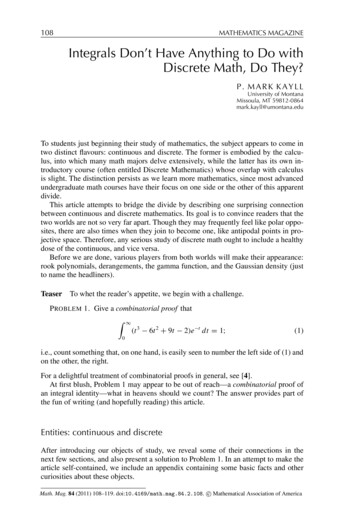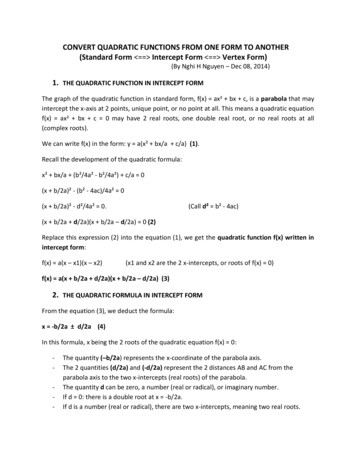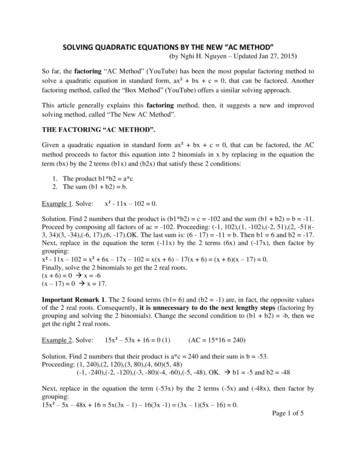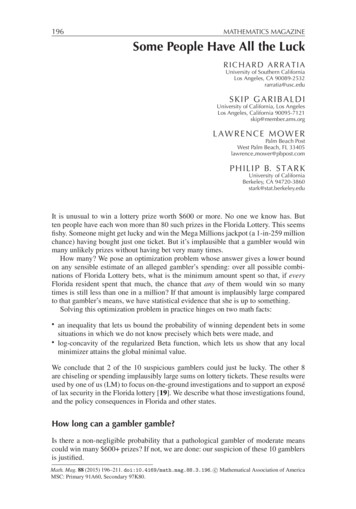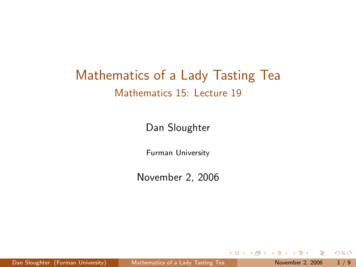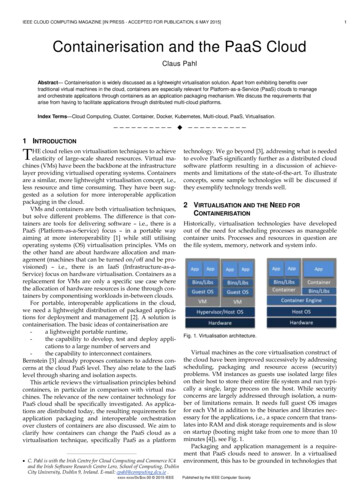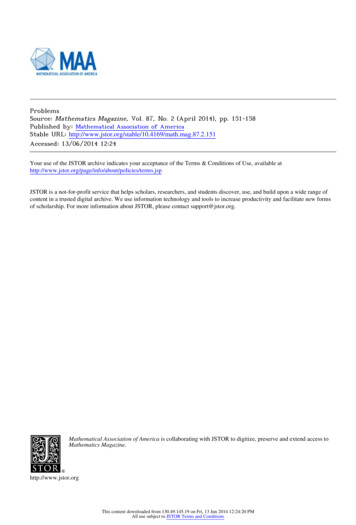
Transcription
ProblemsSource: Mathematics Magazine, Vol. 87, No. 2 (April 2014), pp. 151-158Published by: Mathematical Association of AmericaStable URL: 151 .Accessed: 13/06/2014 12:24Your use of the JSTOR archive indicates your acceptance of the Terms & Conditions of Use, available at ms.jsp.JSTOR is a not-for-profit service that helps scholars, researchers, and students discover, use, and build upon a wide range ofcontent in a trusted digital archive. We use information technology and tools to increase productivity and facilitate new formsof scholarship. For more information about JSTOR, please contact support@jstor.org.Mathematical Association of America is collaborating with JSTOR to digitize, preserve and extend access toMathematics Magazine.http://www.jstor.orgThis content downloaded from 130.49.145.19 on Fri, 13 Jun 2014 12:24:20 PMAll use subject to JSTOR Terms and Conditions
PROBLEMSBERNARDO M. ÁBREGO, EditorCalifornia State University, NorthridgeAssistant Editors: SILVIA FERNÁNDEZ-MERCHANT, California State University, Northridge; JOSÉ A. GÓMEZ, Facultad de Ciencias, UNAM, México; EUGEN J. IONASCU, Columbus State University; ROGELIO VALDEZ, Facultad de Ciencias, UAEM, México; WILLIAMWATKINS, California State University, NorthridgePROPOSALSTo be considered for publication, solutions should be received by September 1,2014.1941. Proposed by Spiros P. Andriopoulos, Third High School of Amaliada, Eleia,Greece.Find all pairs of nonzero real valued functions (u(x), v(x)) that satisfy both of thefollowing equations: u 0 u 0 0 and u 0 v 0 uv.vv1942. Proposed by Marcel Chiriţă, Bucharest, Romania.Let n 2 be an integer. Prove thatnXk 0 nkk 1 kis not an integer.1943. Proposed by Mihály Bencze, Brason, RomaniaLetPnn be a positive integer, and a1 , a2 , . . . , an be positive real numbers. Set A 1k 0 ak and an k ak for 1 k n 1. Prove thatnssrrqn 1qX ak 1 ak 2 ak 3 · · · ak n n A A A · · · A.k 0Math. Mag. 87 (2014) 151–158. doi:10.4169/math.mag.87.2.151. c Mathematical Association of AmericaWe invite readers to submit problems believed to be new and appealing to students and teachers of advancedundergraduate mathematics. Proposals must, in general, be accompanied by solutions and by any bibliographicalinformation that will assist the editors and referees. A problem submitted as a Quickie should have an unexpected,succinct solution. Submitted problems should not be under consideration for publication elsewhere.Solutions should be written in a style appropriate for this M AGAZINE.Solutions and new proposals should be mailed to Bernardo M. Ábrego, Problems Editor, Department of Mathematics, California State University, Northridge, 18111 Nordhoff St, Northridge, CA 91330-8313, or mailed electronically (ideally as a LATEX or pdf file) to mathmagproblems@csun.edu. All communications, written or electronic, should include on each page the reader’s name, full address, and an e-mail address and/or FAX number.151This content downloaded from 130.49.145.19 on Fri, 13 Jun 2014 12:24:20 PMAll use subject to JSTOR Terms and Conditions
152MATHEMATICS MAGAZINE1944. Proposed by Mowaffaq Hajja and Mostafa Hayajneh, Yarmouk University, Irbid, Jordan.For any triangle XYZ with side lengths x, y, and z, let ν(4XYZ) x 2 y 2 z 2 .(a) Let ABCD be a convex quadrilateral with diagonals intersecting at P. Prove that ifν(4PAB) ν(4PBC) ν(4PCD) ν(4PDA),(1)then ABCD is a rhombus.(b) Classify the quadrilaterals ABCD for which there exists a point P (not necessarilythe intersection of the diagonals) such that (1) holds.1945. Proposed by Michael W. Botsko, Saint Vincent College, Latrobe, PA.R1Let f be continuous on [0, 1] and let 0 f (x)d x 0. In addition, let φ(x) be differentiable on [0, 1] with φ(0) 0 and φ 0 (x) 0 on (0, 1). Prove that there existsx0 (0, 1) such thatZ x0φ(x) f (x)d x 0.0QuickiesAnswers to the Quickies are on page 157.Q1039. Proposed by Cezar Lupu, University of Pittsburgh, Pittsburgh, PA.Let x1 , x2 , . . . , xn be real numbers in the interval (0, 1) and let s x1 x2 · · · xn .For 1 i n, let si s xi . Prove thatxxs1 1 s2 2 · · · snxn n 1.Q1040. Proposed by Ovidiu Furdui, Technical University of Cluj-Napoca, Cluj, Romania.Let a b be positive real numbers. CalculatesZ1 n b nlimln (1 enx )d x.n naSolutionsVariety of remaindersApril 20131916. Proposed by H. A. ShahAli, Tehran, Iran.Let M and n be positive integers. For every integer d, let rd be the remainder obtainedwhen n is divided by d. Let Rn {rd : 1 d bn/2c}. Prove that Rn M holdsfor all sufficiently large positive integers n.Solution by Robert Calcaterra, University of Wisconsin-Platteville, Platteville, WI.Suppose that m is an integer such that dn/3e m bn/2c. Then n/3 m n/2 andso 2 n/m 3. Therefore, for each m in the interval, the quotient when dividing byThis content downloaded from 130.49.145.19 on Fri, 13 Jun 2014 12:24:20 PMAll use subject to JSTOR Terms and Conditions
153VOL. 87, NO. 2, APRIL 2014m is 2, and so the remainders rm n 2m must be distinct for distinct m. It followsthatjn k ln m n 1 n 2n 7 Rn ,23236and so limn Rn .Editor’s Note. By considering the range of values m such that 3 n/m 4 and theprinciple of inclusion and exclusion, it can be proved that Rn (5/24)n O(1).The remainders obtained from the range of values m such that 4 n/m 5 are allincluded in the range obtained from 2 n/m 3. The next range that provides newvalues comes from the values m such that 5 n/m 6. In this case, the principleof induction yields Rn (79/360)n O(1). Following this approach, it is possibleto prove that limn Rn /n exists. As pointed by Omran Kouba, numerical evidencesuggests that this the value of the limit is close to 0.229.Also solved by Elton Bojaxhiu (Albania) and Enkel Hysnelaj (Australia), Paul Budney, CMC328, RobertL. Doucette, Dmitry Fleischman, Daniel Fritze (Germany), Eugene A. Herman, Cliff S. Holroyd, Tom Jager,Omran Kouba (Syria), Elias Lampakis (Greece), Reiner Martin (Germany), Peter McPolin (Northern Ireland),José Heber Nieto (Venezuela), Joel Schlosberg, Thomas Steinberger, Traian Viteam (Chile), Edward T. White,Timothy Woodcock, and the proposer.Generalized mean inequalitesApril 20131917. Proposed by Ovidiu Furdui, Technical University of Cluj-Napoca, Cluj, Romania.Let α 0 and let a and b be real numbers such that b a. Find the value ofZ bpn(x a)n (b x)n α((x a)(b x))n/2 d x.limn aSolution by Charles Martin, Vanderbilt University, Nashville, TN.We show that L (3/4)(b a)2 . Let us observe that the integrandpf n (x) : n (x a)n (b x)n α[(x a)(b x)]n/2 ,for x [a, b] and fixed n, is a symmetric Rfunction with respect to x c : (a b)/2.cHence, it is enough to show that limn a f n (x)d x L/2.For x [a, c], we have 0 x a b x, which impliesSinceRcab x f n (x) (2 α)1/n (b x).(b x)d x (3/8)(b a)2 , integrating the above inequality on [a, c] gives3(b a)2 8Zacf n (x)d x (2 α)1/n3(b a)2.8Letting n , because (2 α)1/n 1, the Squeeze Principle gives us the claimedvalue for L.Editor’s Note. Michael Goldenberg and Mark Kaplan sent us an elegant solution basedon known results about the power mean inequalities of positive numbers: α1 a1n α2 a2n · · · αk akn 1/n,Mn : α1 · · · αkThis content downloaded from 130.49.145.19 on Fri, 13 Jun 2014 12:24:20 PMAll use subject to JSTOR Terms and Conditions
154MATHEMATICS MAGAZINEwhere a j 0 and α j 0 for 1 j k. It is known that {Mn } is non-decreasing andconvergent to max1 j k (a j ). By Dini’s theorem, since the sequence f n /(2 α)1/n isnon-decreasing and pointwise convergent to a continuous function, it must convergeRbuniformly. Hence, a f n (x)d x converges toZabp3(b a)2.max(x a, b x, (x a)(b x))d x 4Tomas Persson and Mikael P. Sundqvist showed that L (3/4)(b a)2 , even if α [ 2, 0]. They used a different but clever analysis in the special case α 2.Also solved by Hatef I. Arshagi, Michel Bataille (France), Robert Calcaterra, Robert L. Doucette, JohnN. Fitch, J. A. Grzesik, Eugene A. Herman, Michael Goldenberg and Mark Kaplan, Omran Kouba (Syria), EliasLampakis (Greece), Paolo Perfetti (Italy), Tomas Persson (Sweden) and Mikael P. Sundqvist (Sweden), AmitK. Verma (India), Haohao Wang and Jerzy Wojdylo, and the proposer. There were four incomplete solutions.Solving a cubic geometricallyApril 20131918. Proposed by Kent Holing, StatoilHydro, Trondheim, Norway.A triangle is given with side lengths a, b, c, and with inradius and circumradius r andR, respectively. Let s 21 (a b c) denote the semiperimeter of the triangle.(a) Solve the cubic x 3 (r 4R)x 2 s 2 x r s 2 0 exactly by starting with themonic cubic having roots s a, s b, and s c.(b) Using (a), give a geometrical interpretation of the roots of the given cubic.Solution by Peter McPolin, St. Mary’s University College, Belfast, Northern Ireland.The roots of the given cubic are the exradii ra , rb , and rc of the given triangle, wherera r s/(s a), rb r s/(s b), and rc r s/(s c).Let p(x) denote the monic cubic having roots s a, s b, and s c, that is,p(x) (x (s a))(x (s b))(x (s c)). Upon expansion, we obtain p(x) x 3 σ1 x 2 σ2 x σ3 , where σ1 , σ2 , and σ3 are the elementary symmetric functionsof the roots:σ1 (s a) (s b) (s c) 3s (a b c) s,σ2 (s a)(s b) (s b)(s c) (s c)(s a) 3s 2 2s(a b c) ab bc ca s 2 ab bc ca, andσ3 (s a)(s b)(s c).To express σ2 and σ3 in terms of r , s, and R, we make use of Heron’s formula for thearea A of a triangle, i.e., A2 s(s a)(s b)(s c), and the following two wellknown triangle formulas A r s and abc 4Rr s. We obtainr 2 s 2 A2 s(s a)(s b)(s c) s(s 3 s 2 (a b c) s(ab bc ca) abc) s( s 3 s(ab bc ca) 4Rr s),giving ab bc ca s 2 r 2 4Rr , and hence σ2 r 2 4Rr . It also follows fromthe above that σ3 r 2 s. Thus the cubic p(x) may be expressed asp(x) x 3 sx 2 (r 2 4Rr )x r 2 s.This content downloaded from 130.49.145.19 on Fri, 13 Jun 2014 12:24:20 PMAll use subject to JSTOR Terms and Conditions
155VOL. 87, NO. 2, APRIL 20143222Comparing this form of p(x) with the given cubic x (r 4R)x s x r s , wesee that they are related by means of a simple reciprocal transformation: 3 xrsp x 3 (r 4R)x 2 s 2 x r s 2 .2r sxIt follows that the roots of the given cubic are r s/(s a), r s/(s b), and r s/(s c).These are well-known expressions for the exradii ra , rb , and rc , respectively, of thethree excircles of a triangle having side lengths a, b, and c.Also solved by Arkady Alt, George Apostolopoulos (Greece), Brian D. Beasley, Michel Bataille (France),Elton Bojaxhiu (Albania) and Enkel Hysnelaj (Australia), Robert Calcaterra, Robert L. Doucette, J. A. Grzesik,John G. Heuver, Omran Kouba (Syria), Elias Lampakis (Greece), Raúl A. Simón (Chile), Nicholas C. Singer,Traian Viteam (Chile), Michael Vowe (Switzerland), John Zacharias, and the proposer.Symmetrical packings of circlesApril 20131919. Proposed by Abdurrahim Yilmaz, Middle East Technical University, Ankara,Turkey.Let n 3 be a positive integer. A circle of radius 1 centered at the origin is inscribedby a circular arrangement of n congruent circles, where every two consecutive circlesin the arrangement are tangent. This arrangement is in turn inscribed by a second circular arrangement of n congruent circles in two different ways, as shown in the figuresbelow. In F IGURE 1, the line through the centers of tangent circles in different arrangements goes through the origin. In F IGURE 2, each circle in the second arrangement istangent to two consecutive circles in the first arrangement. Suppose that this processcontinues indefinitely, as shown in the figures. For each of the two cases, find the areaenclosed by the union of all circles when n .Figure 1Figure 2Solution by Tim McDevitt, Sciences, Elizabethtown College, Elizabethtown, PA.For the two cases shown in F IGURES 1 and 2, the arrangements of n tangent circlesare inscribed inside concentric circles of decreasing radius Rk , k 0, 1, 2, . . . , whereR0 1 to coincide with the outermost circle. Let θn π/n; for the n circles in anarrangement to be tangent to each other, they must have radiusrk sin θnRk ,1 sin θn(1)which we deduce from triangle OAB in F IGURE 3. For the case illustrated in F IGURE 1,Rk 1 Rk 2rk , which leads to the recurrence relationRk 1 1 sin θnRk ,1 sin θnThis content downloaded from 130.49.145.19 on Fri, 13 Jun 2014 12:24:20 PMAll use subject to JSTOR Terms and Conditions
156MATHEMATICS MAGAZINEBODAθnAOθnFigure 3Figure 4and thusRk 1 sin θn1 sin θn k.The sum of the areas of all of the circles in F IGURE 1 is easily computed, since theresulting series is geometric:" X 2 #k Xsinθπ 2 sin θn1 sinθπnnnπrk2 nπ n sin θn ,1 sin θn k 01 sin θn44 θnk 0which approaches π 2 /4 when n . For the case shown in F IGURE 2, a similaranalysis follows, except that it is more difficult to relate Rk 1 to Rk . Focusing on angleAOD, the law of cosines applied to triangle OAD in F IGURE 4 gives(rk rk 1 )2 (Rk 1 rk 1 )2 (Rk rk )2 2(Rk 1 rk 1 )(Rk rk ) cos θn ,which, using (1), reduces to2(1 2 f n )Rk 1 2[ f n2 (1 f n )2 cos θn ]Rk Rk 1 (1 2 f n )Rk2 0,where f n sin θn /(1 sin θn ). Applying the quadratic formula and simplifying yields cos θn sin2 θn sin θn 1 2 cos θnRk ,Rk 1 cos2 θnwhere the minus solution is chosen so that Rk 1 Rk . This implies that kcos θn sin2 θn sin θn 1 2 cos θnRk ,cos2 θnand thus the sum of the areas of the circles in F IGURE 2 is" 2 X 2 #k Xsin θncos θn sin2 θn sin θn 1 2 cos θn2nπrk nπ1 sin θncos2 θnk 0k 0π 2 sin2 θn cos4 θn, θn (1 sin θn )2 (cos4 θn (cos θn sin2 θn sin θn 1 2 cos θn )2 ) which approaches π 2 /(2 3) as n . This content downloaded from 130.49.145.19 on Fri, 13 Jun 2014 12:24:20 PMAll use subject to JSTOR Terms and Conditions
157VOL. 87, NO. 2, APRIL 2014Also solved by Elton Bojaxhiu (Albania) and Enkel Hysnelaj (Australia), Robert Calcaterra, William Dickinson, Robert L. Doucette, John N. Fitch, Dmetry Fleischmann, J. A. Grzesik, Eugene A. Herman, HidefumiKatsuura and Edward Schmeichel, Omran Kouba (Syria), Victor Kutsenok, Hosam M. Mahmoud, Howard CaryMorris, Ángel Plaza (Spain) and José M. Pacheco (Spain), Kevin A. Roper, John Zacharias, and the proposer.There were two incomplete or incorrect solutions.An identity of sums of binomialsApril 20131920. Proposed by Ilya Bluskov, University of Northern British Columbia, PrinceGeorge, Canada.For every positive integer n, prove that n Xn mX( 2)r 2n m rm 0 r 0m!r !n nX( 1)r 2n r .r!nr 0Solution by Thomas Steinberger, Ohio Northern University, Ada, OH.Let k m r . It follows that the double sum above becomes n XnX( 2)k m 2n k.nm!(k m)!m 0 k mBy interchanging the sums, we have k k nnXX1 2n k X ( 2)k m k!1 2n k Xk m k ( 2)k!nm!(k m)!k!nmk 0k 0m 0m 0 nX1 2n k(1 2)k nk!k 0 nX( 1)k 2n k,k!nk 0as desired.Also solved by Aleams Barra (Indonesia), Michel Bataille (France), Robert Calcaterra, Eddie Cheng, RobertL. Doucette, Daniel Fritze (Germany), Omran Kouba (Syria), José Heber Nieto (Venezuela), Ángel Plaza (Spain),Joel Schlosberg, Timothy Woodcock, William Xiao, and the proposer.AnswersSolutions to the Quickies from page 152.A1039. We use Bernoulli’s inequality for real exponents: (1 x)r 1 r x for x 1 and 0 r 1. For every 1 i n, xi xi 11s si xi1 1 1 1 1 xi .sisisisiIt follows thatxsi i sisi .s si xisThis content downloaded from 130.49.145.19 on Fri, 13 Jun 2014 12:24:20 PMAll use subject to JSTOR Terms and Conditions
158MATHEMATICS MAGAZINEAdding these inequalities for 1 i n, we obtainnxxs1 1 s2 2 · · · snxn n1X11Xsi (s xi ) (ns s) n 1.s i 1s i 1sA1040. The limit equals b. First, note that the integrand satisfies the following inequalities: n n x n lnn (enx ) lnn (1 enx ) lnn (1 enb ). Thus,sssZZn 1 a n 11 n b n n1 n b nn b n x dx ln (1 enx )d xn 1nnaa ln(1 enb ) n· b a.nA direct calculation shows thatln(1 enb ) n· b a bn nlimandslimn nbn 1 a n 1n 1 lim b n · limn n n 1rn1 a n 1b· lim nn It follows, based on the Squeeze Theorem, thatsZ1 n b nlimln (1 enx )d x b.n naThis content downloaded from 130.49.145.19 on Fri, 13 Jun 2014 12:24:20 PMAll use subject to JSTOR Terms and Conditions1n 1 b.
154 MATHEMATICS MAGAZINE where aj 0 and j 0 for 1 j k. It is known that fMngis non-decreasing and convergent to max1 j k.aj/. By Dini’s theorem, since the sequence fn .2 C /1 n is non-decreasing and pointwise convergent to a continuous function, it must converge uniformly. Hence, Rb a fn


